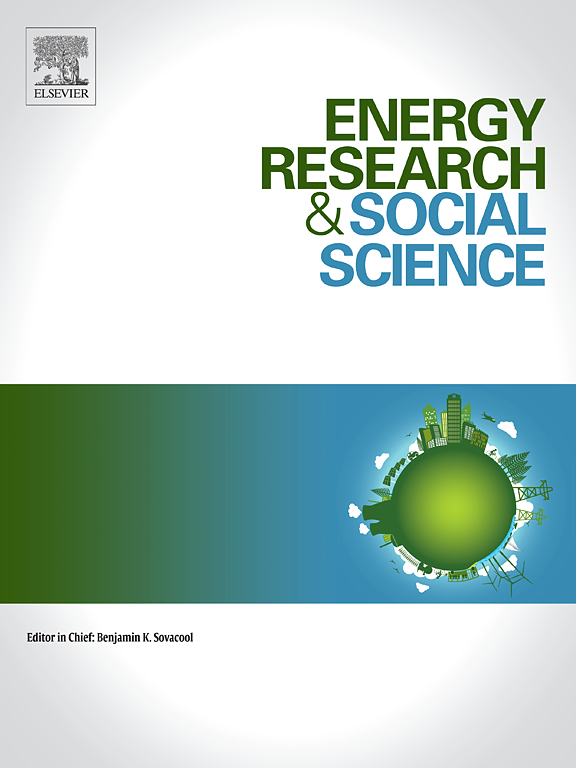领先还是落后?验证一种简单的措施,以前瞻性地确定低排放技术的采用者类别
IF 7.4
2区 经济学
Q1 ENVIRONMENTAL STUDIES
引用次数: 0
摘要
采用低排放技术对减缓气候变化至关重要,但许多消费者尚未这样做。罗杰斯(2003)的创新扩散模型,以及根据采用创新的速度将消费者分类为动机不同的采用者类别,似乎是解决这一挑战的有用工具,允许为不同采用者类别的消费者量身定制低排放技术采用策略。然而,防止这种潜在的应用是采用传统的采用者类别分类的回顾性方法。因此,本研究的目的是评估一种确定采用者类别的前瞻性方法:要求消费者自我确定他们所属的低排放技术采用者类别。在两个澳大利亚样本(合计n = 2645)中,我们发现三种低排放技术(电动汽车、电供暖、电/太阳能热水)的当前和计划采用模式总体上与罗杰斯的理论一致,即使在控制了采用的潜在障碍(例如,财务资源、在家中居住的时间长度、采用成本)之后也是如此。唯一的例外是创新者和早期采用者,没有观察到一致的采用者差异。尽管存在这种例外,自我确定的采用者类别代表了一种有效和快速的方法,可以对消费者的采用者类别进行前瞻性分类,从而允许开发适合每个采用者类别的动机概况的低排放技术采用策略。本文章由计算机程序翻译,如有差异,请以英文原文为准。
Leading the pack or lagging behind? Validating a simple measure to prospectively identify adopter categories for low emission technologies
Adopting low emission technologies will be fundamental to mitigating climate change, yet many consumers have yet to do so. Rogers' (2003) diffusion of innovations model, and its categorisation of consumers to motivationally distinct adopter categories defined by how fast an innovation is adopted, would appear to be a useful tool for addressing this challenge, allowing low emission technology adoption strategies to be tailored to consumers in different adopter categories. Preventing this potential application, however, is the retrospective means by which adopter category classification traditionally occurs. The purpose of this research was therefore to evaluate a prospective method for determining adopter category: asking consumers to self-identify the low emission technology adopter category to which they belong. Across two Australian samples (combined n = 2645), we found that current and planned adoption patterns for three low emission technologies (electric vehicles, electric space heating, electric/solar water heating) were generally consistent with those theorised by Rogers, even after controlling for potential barriers to adoption (e.g., financial resources, length of time residing in one's home, adoption costs). The one exception was for innovators vs. early adopters, where no consistent adoption differences were observed. Notwithstanding this exception, self-identified adopter category represents a valid and expeditious means for prospectively classifying a consumer's adopter category, allowing for the development of low emission technology adoption strategies that are tailored to the motivational profile of each adopter category.
求助全文
通过发布文献求助,成功后即可免费获取论文全文。
去求助
来源期刊

Energy Research & Social Science
ENVIRONMENTAL STUDIES-
CiteScore
14.00
自引率
16.40%
发文量
441
审稿时长
55 days
期刊介绍:
Energy Research & Social Science (ERSS) is a peer-reviewed international journal that publishes original research and review articles examining the relationship between energy systems and society. ERSS covers a range of topics revolving around the intersection of energy technologies, fuels, and resources on one side and social processes and influences - including communities of energy users, people affected by energy production, social institutions, customs, traditions, behaviors, and policies - on the other. Put another way, ERSS investigates the social system surrounding energy technology and hardware. ERSS is relevant for energy practitioners, researchers interested in the social aspects of energy production or use, and policymakers.
Energy Research & Social Science (ERSS) provides an interdisciplinary forum to discuss how social and technical issues related to energy production and consumption interact. Energy production, distribution, and consumption all have both technical and human components, and the latter involves the human causes and consequences of energy-related activities and processes as well as social structures that shape how people interact with energy systems. Energy analysis, therefore, needs to look beyond the dimensions of technology and economics to include these social and human elements.
 求助内容:
求助内容: 应助结果提醒方式:
应助结果提醒方式:


